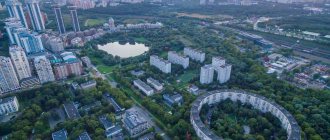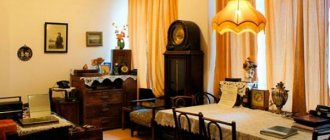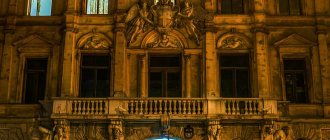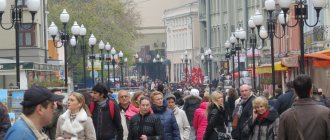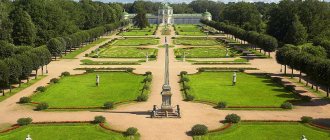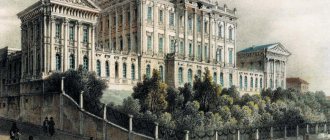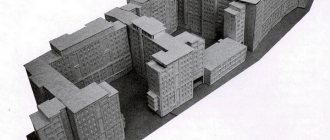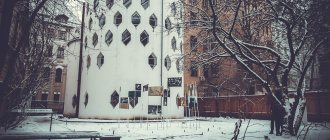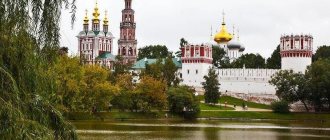History of creation
Praskovya asked her husband for a long time to open a hospice house where homeless, poor, crippled people could receive free treatment and a roof.
The couple together chose a place for construction on what was then the outskirts of Moscow, behind Zemlyanoy Val near Sukharevskaya Square. The first project of a charitable institution was developed by Bazhenov’s student, serf architect Elizvoy Nazarov. The house church in the center of the building divided it into two wings, a hospital and an almshouse. The convenient entrance for delivering patients was decorated with double columns. Sheremetev's extensive charitable activities were glorified by the court poet Gabriel Derzhavin: No, no, it is not such luxury that He is glorified in the world today, The tables have passed like an empty dream. The guests soon forget them: But in this way he gained the love of all, That he gave to the poor and protection to the sick.
After the death of his wife, the inconsolable Count Sheremetev instructed his friend, the architect Giacomo Quarenghi, to rebuild the building of the Hospice House so that it would become a majestic monument to his deceased wife. The worthy but simple building of Nazarov had to be turned into a magnificent palace that had no analogues in world architecture.
Architect Giacomo Quarenghi did not go to Moscow for construction, but sent projects, drawings and drawings by mail. His plans were embodied on the spot by Russian architects Mironov, Dikushin and Argunov, who built estates in Kuskovo and Ostankino for the Sheremetev family.
Quarenghi replaced the simple portico with a grandiose semicircular colonnade, which gave the building solemnity and sublimity, decorated the ends of the wings with six-column porticoes, and added four wings to the ensemble. The decoration of the building, its decor and interior details were made from the best and most expensive materials; in total, the count spent three million rubles on construction - a colossal amount for those times.
Nikolai Sheremetev only a few months did not live to see the opening of the Hospice House. It took place on his birthday - June 28, 1810, with a huge crowd of people. The Sheremetev family strictly carried out the will of Nikolai Petrovich, taking an active part in the fate of the house and donating huge sums for its maintenance.
Kuznetsova, Kovalev, Gorbunova, Zhemchugova, Sheremetev
It all started back in 1773.
Count Nikolai Petrovich Sheremetev returned from a trip abroad to the family estate of Kuskovo, which was distinguished, among other things, by its brilliant serf theater. And he immediately drew attention to the serf actress Praskovya (Parasha) Kuznetsova, aka Kovaleva, aka Gorbunova. The point here is not two marriages - it’s just that Parasha’s father was a blacksmith or, as they said at that time, a farrier, and also hunchbacked. Hence the three nicknames. And her stage name was in the gypsy style - Zhemchugova.
A description of Parasha’s appearance has been preserved: “There was neither antique, nor classical, nor artistically correct beauty in her... on the contrary, from this point of view the forehead would be found small, the eyes are not sufficiently outlined with clear lines and are not large, and at the edges they are somewhat stretched out. oriental, there is no luxury in the hair, the cheekbones protrude too noticeably, the coloring of the face is either softly weak or dark and burnt. But... the soul is expressed here.”
And Count Sheremetev fell in love like a young man. He wrote: “I changed feasts into peaceful conversations with my loved ones and sincere ones, theatrical spectacles were replaced by the spectacle of nature, the works of God and human deeds, shameful love was driven out of my heart by constant, sincere, tender love.”
Despite the public mood of the time (and they were strict and merciless), Nikolai Petrovich married his beloved. Previously, he “straightened out” some false pedigree for her, but he failed to deceive the Moscow gossips: they were talking about misalliance everywhere.
Portrait of N. P. Sheremetev by N. I. Argunov. 1801-1803 Image from wikipedia.org
True, this did not bother the count. He is in love, we love him in return, he has money. He decided to spend part of this money on charity and began to build a huge, as they said at that time, hospice house on Sukharevskaya Square to provide medical care and shelter to the Moscow poor.
The first stone was laid in 1792, and shortly before the completion of construction work, Parasha died from a pulmonary process.
The count wrote: “The death of my wife, Countess Praskovya Ivanovna, struck me so much that I do not hope to calm my suffering spirit with anything other than one benefit for the needy, and therefore, wanting to finish the long-begun construction of the Hospice House, I made an assumption about the structure of it, separating a significant part of my dependency.”
Fortunately, their son Dmitry was born - the Sheremetev family did not die out, and right up to the revolution there was someone to take care of the building on Sukharevka.
Nikolai Petrovich himself grieved terribly, could not survive the terrible loss and passed away a few years later, without waiting for the first guests to appear in the hospice house - named, of course, in honor of his beloved wife.
And Gabriel Derzhavin dedicated poems to him:
No, no, it is not such luxury that He is glorified in the world today, The tables have passed like an empty dream. The guests soon forget them: But in this way he gained the love of all, That he gave to the poor and protection to the sick.
Social activity
According to the spiritual will of Praskovya Sheremeteva, funds were allocated annually for dowries to “poor and orphaned girls.” Girls in need of help drew lots on February 23, the day of memory of Praskovya, and orphan brides were married in the Trinity Church of the Hospice House.
More than 200,000 people received help at home. Since the beginning of the 19th century, the Moscow branch of the Medical-Surgical Academy settled here. By the end of the century, the hospital’s ties with Moscow University were strengthened: in 1884 it became its clinical base. Leading scientists of the country V.D. Shervinsky, S.S. Zayaitsky, N.N. Savinov, S.N. Dobrokhotov and S.E. Berezovsky are introducing advanced treatment methods here.
An important stage in the history of the house was the work of the chief doctor, Alexey Terentyevich Tarasenkov. Under him, hospital care was significantly improved: outdated prescriptions for drugs were replaced, control over their purchase and prescription was established, and regular rounds and examinations of patients were established. He suggested to the then trustee of the house, Count S.D. Sheremetev to open a “coming department” - a free outpatient clinic, as well as a medical fund for issuing benefits to patients upon discharge for the first time, which was done.
During its operation, the Sheremetevskaya Hospital more than once turned into a hospital. After the Battle of Borodino, wounded soldiers and officers were brought here. On the day the French entered Moscow, the house was empty, 32 infirm and elderly people remained in the almshouse, and 11 wounded Russian officers remained in the hospital. Some employees and doctors stayed with them voluntarily. Mistaking the Hospice House for a manor house, the French began to rob it, but when they learned that it was a charitable institution, on the contrary, they posted a guard there. Many valuables were nevertheless stolen. During the fire, the Sukharevsky and Doctor's wings were damaged, only the walls remained. The house took several more years to be restored.
During the terrible cholera epidemic of 1830, no one fell ill in the Hospice House.
During the Crimean War, a sanitary detachment of doctors was assembled here. During the Russo-Japanese War, the infirmary operated on a charitable basis. Later, participants in the revolutions of 1905 and 1917 were treated. In 1919, the Moscow city emergency medical care station was organized in the Hospice House, and since 1923, one of the buildings of the Research Institute of Emergency Medicine named after. N.V. Sklifosovsky. The initiative to restore the Hospice House and return it to its former glory belonged to the surgeon Sergei Sergeevich Yudin.
Chief surgeon of the Research Institute named after. Sklifosovsky S.S. Yudin was the elder of the Trinity Church and donated the Stalin Prize for the restoration of its paintings.
In 1986, the Central Museum of Medicine opened here, which in October 1991 received the status of the Research Institute of the Russian Academy of Medical Sciences.
The ensemble of the Hospice House - the main building, two side wings, two wings in the courtyard, a gate and a fence, a fresco by Giovanni Scotti in the dome of the church, high reliefs in the interiors of sculptors G. Zamaraev and T. Timofeev - is included in the list of cultural heritage sites of federal significance and is included in provisional UNESCO World Heritage List.
Text of the book “The History of the Hospice House”
E. M. Altaiskaya, A. A. Bulatnikova, A. V. Malozemova History of the Hospice House
[broken link]
Prospekt Publishing House cordially congratulates the team of the Research Institute of Emergency Medicine named after. I. B. Sklifosovsky with the 200th anniversary of the Hospice House. We express our sincere gratitude to the directorate and staff of the Institute for their assistance in preparing the book.
Introduction
"UNTIL THE SUN IS BLACKNESS..."
“As for healthy people, who for some reason fall into temporary need and are worthy of help, the work of true charity is to extract them from this need and reintroduce them into the respectable society of people who earn their bread by their labor. It is obvious that such a goal can only be achieved by a reasonable and sufficient prescription of assistance,” wrote in 1860 the remarkable doctor Alexei Terentyevich Tarasenkov, senior doctor of the Hospital for Hospice, founded in Moscow by Count Nikolai Petrovich Sheremetev.
The institution, which performed the functions of a hospital and at the same time provided assistance to people who, by the will of fate, found themselves in a difficult financial situation, celebrated its half-century anniversary (the doors of the Sheremetev Hospital were officially opened on June 28, 1810).
During this time, a lot was done: the Hospice House received Russian and French soldiers wounded near Borodino, coped with the cholera epidemic without a single case of this disease among the employees, gave bread and shelter to soldiers maimed in the Crimean War. The best doctors, scientists, artists, architects contributed to the history of the House, and the crowned persons of the Russian state did not ignore it. Representatives of the Romanov dynasty were familiar with the trustees of this institution that was ahead of its time and more than once took part in the fate of the Sheremetev family.
And subsequently, not a single significant event in Russian history will bypass the Hospice House. The Russian-Turkish War will flare up in the Balkans - a medical detachment formed in the House will be sent to the theater of military operations, wounded soldiers will be evacuated directly to the Sheremetev hospital, and the trustee of the House, Count Sheremetev, will go to the active army together with the heir to the throne - the future Emperor Alexander III. Far East, at night the Japanese, without declaring war, will attack the Russian squadron in Port Arthur - the infirmary of the Red Cross Society will immediately open within the walls of the Sheremetev hospital. Following these events - the December uprising of 1905, the First World War... Doctors of the hospital at the Hospice House will provide medical care to everyone who needs it.
The Romanov Empire will fall, the name of Count Sheremetev’s Hospice House will disappear in Moscow, but its essence will not change - here, as before, human lives will be saved at any time of the day or night.
The unique medical institution celebrates its bicentennial anniversary in 2010. The majestic building, built at the beginning of the 19th century according to the design of the architect Quarenghi, has now been restored, and its original name - the Hospice House - glittered in gold. There have been several of them throughout its history: in 1923, the Sheremetevskaya Hospital was renamed the N.V. Sklifosovsky Research Institute of Emergency Medicine.
During the Great Patriotic War, the Research Institute of Emergency Medicine named after N.V. Sklifosovsky, like a century ago, will receive and return thousands of wounded to duty. Doctors of the Institute will advise their colleagues on the front line and perform demonstration operations.
More than a decade has passed. The hospice house will be equipped with modern buildings, and new clinical departments will open. Doctors of the Institute will enrich world medical practice with new methods of treatment and surgical operations that will give a chance for a new life to once hopeless patients. Their experience will be adopted, and doctors from all over the country will come for consultations.
On the day of the opening of the Hospice House, in the summer of 1810, prophetic words were spoken: “And until the sun is darkened, until the world exists, until then the blessings of this place will remain unchanged.”
On the day of the bicentenary of the Institute, I would like to wish it exactly this - so that a place where any person at any time of the day can receive the necessary highly qualified help will continue to be famous for its achievements, preserving the excellent skill of its doctors and the enormous practical value of its scientific developments, which determine the development of modern medicine...
Chapter 1 HISTORY OF THE PLACE
“The fate of Moscow in all events was joined to the fate of the whole state. She participated in the prosperity and glory of Russia, but shared with her disasters and humiliations. Many places in Moscow, some buildings, preserved shrines and various things are marked by ancient incidents and bring them to memory,” wrote Alexei Fedorovich Malinovsky, the first chief caretaker of the Sheremetev Hospital, in 1820 in the dedication of his book “Review of Moscow.” The author of the “Review...” spoke in detail about the surroundings of the Palace of Mercy, located on what was then the city outskirts.
The territory on which the Sheremetev Hospice House was built in the 19th century was most closely connected with the most important episodes in the history of the Russian state and its ancient capital.
The first name of this area, known since the founding of Moscow, is Kuchkovo Field. Kuchka was the name given to the semi-legendary boyar on whose lands, according to legend, Prince Yuri Dolgoruky founded the new city.
In the 14th century, it was here that an event took place, revered in Orthodoxy as miraculous, and for the glory of which the walls of the Sretensky Monastery were erected on the field.
In 1395, the army of thousands of Timur-Tamerlane, the most formidable and merciless conqueror since Genghis Khan, advanced deep into Rus', betraying everything in its path to fire and sword. Yelets had already fallen and was plundered, and the troops of the Iron Lame stood in the upper reaches of the Don, preparing to march to the capital. Grand Duke Vasily Dmitrievich - the eighteen-year-old son of Dmitry Donskoy - gathered an army and took up defense in Kolomna. Moscow residents hastily fortified the settlement with a ditch from Kuchkov Field to the Moscow River. Metropolitan Cyprian “to calm the despairing” sent messengers to Vladimir for the icon of the Mother of God, painted by the Evangelist Luke.
Alexey Fedorovich Malinovsky
Under the vigilant guard of the princely warriors, the image of the Most Pure One was carried in their arms from Vladimir to Moscow for almost two weeks. On August 26, Muscovites with hope and joy awaited the appearance of the procession on the road running from the Nikolsky Gate to Kitay-Gorod. The meeting (or meeting) of the icon took place near the Church of St. Mary of Egypt on Kuchkovo Field. They carefully placed the image near the wooden temple and held a service in honor of its safe arrival. Metropolitan Cyprian, Prince of Serpukhov Vladimir Andreevich, Moscow boyars and other townspeople kneeled in prayer to the Heavenly Intercessor. Exclamations were heard: “Mother of God! Save the Russian land! After the prayer service, the shrine was moved to the Kremlin, where it was placed in the altar of the Assumption Cathedral.
Vladimir Icon of the Mother of God
On the same day, “the advanced guards soon announced” that Timur, together with “his vast hordes,” had turned back: historians are still at a loss as to why the great conqueror so suddenly abandoned the plan of attacking Moscow. Soon, at the site where the icon was found, a monastery was founded in the name of the Presentation of the Vladimir Icon of the Mother of God. The gate at which the holy face was met began to be called Sretensky, and the street - Sretenka (as well as Vtretenka, Ustretenka, Ustretenskaya, Bolshaya Ustretenskaya street).
Since then, every year on August 26, in memory of the day when the Mother See was saved from Tamerlane, a religious procession from the Assumption Cathedral was held at the Sretensky Monastery. At the time of writing “Review of Moscow” there were two more memorable religious processions. On May 21, a procession of the cross, ordered by Grand Duke Vasily Ivanovich, went to the monastery after “preserving the capital harmlessly during its occupation by the Crimean Khan Magmet-Girey.” And on June 23, Muscovites remembered the year 1480 - the day of final liberation from the Tatar yoke (this religious procession was established by Ivan III).
The Moscow Review describes the internal structure of the Sretensky Monastery as follows:
“There are three churches inside the fence, built separately.
1. The cathedral church in the name of the Mother of God, the Presentation of Her icon in this place, brought from Vladimir. The building is quite tall, about five chapters, of Gothic architecture.
2. St. Nicholas the Wonderworker with chapels: one in the name of All Saints, the other - St. Demetrius, Metropolitan of Rostov. This church is located along Sretenskaya Street and does not have any architectural decorations.
3. Venerable Mary of Egypt, inside the monastery fence. Low-lying, single-domed, in which the miraculous icon of Vladimir was found. Above the holy gate, the bell tower is octagonal, low, with half-columns. On three sides there are abbots’ and fraternal cells.”
The Sretenskaya Church, initially wooden, was rebuilt several times. In 1471, Ivan III ordered Pskov craftsmen to make it of stone. Remaining dissatisfied with the erected temple, the king ordered its destruction. In 1482, construction work began again - already under the leadership of the famous Italian architect Aristotle Fioravanti. Two years later the building was ready.
Sretensky Monastery became the center of Russian spirituality and in subsequent centuries more than once participated in significant events for the state. Thus, on October 29, 1552, the conqueror of the Kazan Khanate, Ivan IV the Terrible, was publicly greeted in front of the holy gates of the monastery. In 1700, the Duma clerk Emelyan Ukraintsev, the Russian envoy to Constantinople, brought to the monastery a particle of the relics of the Venerable Mary of Egypt (with a letter from the Jerusalem Patriarch Dosifei about the authenticity of the shrine).
In 1812, the holy icon of the Vladimir Mother of God was returned to the monastery. The Moscow vicar Augustine, saving the holy image, retired with it to Vladimir, and after the expulsion of the invaders from Moscow, he returned it to the monastery and placed it in the cathedral church. On December 12, 1812, before the face of the Mother of God, the many years of Emperor Alexander I were sung. Muscovites prayed for the final expulsion of the enemy - the French hordes from Russian land.
The Moscow land survey books of 1762 and 1768 contain the most ancient information about the site on which the Sheremetev Hospital was built. The first tsar of the Romanov dynasty gave “the vegetable garden land beyond the Sretensky Gate” to his cousin, Prince Ivan Borisovich Cherkassky. Based on the owner’s name, the place received the nickname “Cherkasy Vegetable Gardens” (at that time it was located outside of Moscow). From the east, the “gardens” were adjacent to Spasskaya Sloboda, from the west – to the future Meshchanskaya Sloboda. The ancient Yaroslavl road began nearby; from the capital it led to Sergiev Posad and further to the north. Pilgrims, including princes and kings, traveled along it to the Trinity-Sergius Lavra to venerate the relics of St. Sergius of Radonezh. Along the way, the pilgrims stopped with the residents of the “gardens”: even during the reign of Mikhail Romanov, 250 people lived in the 48 courtyards of the settlement. A huge earthen rampart ran from the Red Gate to the Sretensky Gate, so named in honor of its proximity to the monastery.
In 1671–1672 - after a long Russian-Polish war - people from Ukrainian, Belarusian, and Lithuanian cities who ended up in Russia as prisoners of war began to settle near the Sretensky Gate. This is how the Meshchanskaya Sloboda arose (the townspeople were called meshchans - from the Slavic words “place”, “misto”, “myasto”, that is, city). The houses of the first settlers became the beginning of 1st Meshchanskaya Street, modern Mira Avenue. Soon, more streets with the same name were formed in the capital. On 3rd Meshchanskaya, in the building of the former Quarantine Yard, in 1775 the Catherine Hospital with an almshouse opened its doors.
At the end of the 17th century, on the site of the Sretensky Gate, near the Streletskaya Settlement, the gates of the Sukharev Tower were already being built. Soon the princely possessions began to be called “the Cherkasy vegetable garden, behind the Sukharev Tower.”
The building received its name in honor of Colonel Lavrentiy Sukharev, who commanded the archers guarding the Sretensky Gate of Zemlyanoy City. In 1689, during an attempted rebellion by Princess Sophia against her brother, the legal heir to the throne of Peter I, Sukharev’s regiment - one of the few rifle regiments - supported the future great emperor.
The construction, which began in 1692, was supervised by the architect Mikhail Ivanovich Choglokov. A passage gate was installed on the lower floor of the tower, and guards were also located there. The second floor was occupied by chambers, around which there was a gallery. In 1698–1701, a third floor appeared, and above it - a four-tiered clock tower. The chambers of the second floor housed Russia's first school of mathematical and navigational sciences, created by Peter I. And in the upper tier of the tower an astronomical observatory was equipped, where one of the tsar's associates, the brilliant self-taught scientist Yakov Bruce, observed the starry sky (still on the modern avenue The house where he lived has been preserved at No. 12).
The people fell in love with the tower: they began to jokingly call Sukhareva the young lady and ask her to marry Ivan the Great - the central bell tower of the Kremlin.
In the 1780s, the already long-existing trade grew at the tower gates. It was possible to buy not only food supplies here: they traded in the market old things, and - sometimes - valuable works of art, and even ancient books and manuscripts. Later, Sukharevka and its inhabitants were masterfully depicted in his notes by the unsurpassed writer of everyday life in Moscow, Vladimir Alekseevich Gilyarovsky.
In 1649, the Church of St. Xenia was built on the “garden land.” This name was the name of the sister of the first owner of the “vegetable gardens”, as well as the mother of the founder of the Romanov dynasty, Tsar Mikhail Fedorovich. The temple was a brownie: they served in it from time to time, at the request of the prince. The parishioners were princely serfs and residents of Spasskaya Sloboda, which at that time did not have its own church. At the Xenin Church there was also an almshouse, where about fifty aged lordly servants lived. In 1654, after a pestilence, 110 of the 423 inhabitants of the “garden” survived. In the Patriarchal order Fr. In 1689, Patriarch Joachim gave Prince Mikhail Yakovlevich permission to build a new wooden church with an almshouse.
In 1722, Prince Alexei Mikhailovich Cherkassky, the grandfather of the founder of the Hospice House, Nikolai Petrovich Sheremetev, died. His widow, Princess Maria Yurievna Cherkasskaya (née Trubetskaya), in memory of her husband, erected a new church, consecrated in the name of the Life-Giving Trinity, with three chapels - the Holy Trinity, the Holy Archangel Michael and the Venerable Xenia (an almshouse was also built at the rebuilt church). Work began in 1743. In the same year, the daughter of Prince and Princess Cherkassky, Varvara Alekseevna, married Count Pyotr Borisovich Sheremetev, “vegetable gardens” formed part of her dowry. The Church of the Life-Giving Trinity was popularly called Kseninsky in the same way. The almshouse continued to exist: in the 1790s, fifty people (mostly the servants of Count Sheremetev) received shelter there. In 1796, Joseph Ivanov, the last priest of the Kseninsky Church, died. In 1800, on the orders of Metropolitan Platon of Moscow, the temple was abolished due to dilapidation. Since 1810, all church utensils and the parish were given to the new church of the Hospice House, also consecrated in honor of the Life-Giving Trinity.
Chronological table
Chapter 2 BUILDING A HOUSE
Count Nikolai Petrovich Sheremetev
“In all centuries and among all peoples, poor people who have no means of subsistence, dejected by illness and in poverty due to the large number of their families, attracted the prudent attention of sovereigns and aroused the compassion of abundant citizens...” – Count Nicholas wrote to Emperor Alexander I in April 1803 Petrovich Sheremetev, grandson of Peter I’s associate Field Marshal Boris Petrovich Sheremetev, under whose brilliant leadership the Russian army won the Battle of Poltava. “Guided by the immutable duties of the Christian law and following the impulses of patriotic zeal,” he continued in his address to the sovereign, “I have long ago decided to establish in Moscow a hospice house for the maintenance of an almshouse in it, at my expense, consisting of one hundred people of both sexes and poor people of all ranks.” and the crippled and a hospital for 50 people for non-monetary treatment there for all conditions of the poor.”
Field Marshal Boris Petrovich Sheremetev
The future Sheremetevskaya Hospital - as the people will call the Hospice House - was built in memory of the count's beloved wife (former serf actress) Praskovya Ivanovna, who died in the same 1803, three weeks after the birth of her son Dmitry. Sheremetev felt that he would not live long after the irreparable loss (the premonition turned out to be prophetic), and in a letter to the emperor he mentioned his possible death and the actions prescribed in its case. He wanted the charity home to become a monument to his late wife, who herself took part in the creation of a charitable institution. The opening was sure to take place on February 23, the day of Praskovya Ivanovna’s death, with the consecration of the Hospice Church in honor of St. Demetrius of Rostov and the commemoration of the Countess. On the same day, the count ordered the distribution of 50 thousand rubles “for alms and for all sorts of charitable deeds that are useful to society.”
The ancient Sheremetev family was known long before the era of Peter the Great - both for its military exploits and for its good deeds. Even during the time of Ivan the Terrible, boyar Sheremetev “exhausted all his estate” for the poor. When the sovereign asked him: “Where did you put your property?”, the boyar answered: “He let him go with the poor to the next world.”
Coat of arms of the Sheremetev family
Nikolai Petrovich’s decision to build a hospital and an almshouse with it did not arise suddenly. His father, Pyotr Borisovich Sheremetev, in 1788, just before his death, spoke about the desire to build a stone “gofspital” for the poor in the “Cherkasy garden, behind the Sukharev Tower” in Moscow. The old count once took these lands near the Sretensky Gate, among other movable and immovable property (including the estates of Ostankino, Maryina Roshcha and others) as a dowry for his wife Varvara Alekseevna: she belonged to the richest family of the Cherkassky princes, who were related to the Romanovs, and was considered at that time the most enviable bride in Moscow. As a result of this union, the Sheremetevs became the owners of one of the largest fortunes of the empire. However, earthly well-being did not overshadow noble thoughts about mercy towards others and the salvation of the soul. Four years after the death of Pyotr Borisovich, thanks to the efforts of the heir, his intention began to take on material embodiment: a construction plan was drawn up and the first stone was laid in the foundation of the future Hospice House.
Alexey Sergeev, the compiler of the book “Review of Count Sheremetev’s Hospice House in Moscow,” published in 1843, noted on its pages that “the time of the laying of the building and the celebration that accompanied it are not known, because the papers relating to these circumstances were lost during the Patriotic War 1812; however, we can confidently believe that all this happened around 1804.”
For more than a hundred years, until 1954, the day of foundation of the building was not known. When work began on the restoration and reconstruction of the architectural monument, a cut stone covered with a sheet of red copper was found under the colonnade of the Church of the Life-Giving Trinity at a depth of two meters. On the stone one could read:
1792 June 28 days the builder of this count
Nikolay Sheremetev.
Behind the copper plate was a niche. Silver coins (from five kopecks to fifty kopecks) from the times of Elizabeth and Catherine the Great were found there.
Nikolai Petrovich inherited from his father not only a huge fortune and a covenant of mercy, but also a great passion for the theater, to which he paid tribute in full before completing the charitable undertaking conceived by his parent.
Pyotr Borisovich himself was one of the first creators of the serf theater in Russia; his son glorified the Sheremetevs’ home theater throughout the empire. In the Kuskovo estate, in addition to the Green and Maly theaters already opened there, the young count erected another one, and then in the Ostankino estate he built the largest theater building of that era. Patron of the arts, philanthropist, Nikolai Petrovich made acquaintances with many artists, sculptors, and architects. He had a particularly close relationship with the famous architect Giacomo Quarenghi, whom he helped in planning the construction of the Moscow Art Museum and involved in the design of structures in his own estates. The Count spared no expense in supporting young talents. However, the theater remained the focus of his thoughts.
“He was interested in medicine and strived for the society of doctors, following the movement of science. The external gloss of a European did not drown out his Russian roots. The whole makeup of the Russian person was alive in him, with his customs and beliefs - with a pure confession of Orthodoxy. He grew up in an environment inherited from the eighteenth century. His nanny was the peasant woman Ekaterina Dedeshina, who lived out her life in the house - already in old age,” the grandson of Count Nikolai Petrovich Sheremetev, historian Sergei Dmitrievich Sheremetev, wrote about his grandfather.
As soon as he accepted his father’s inheritance, Nikolai Petrovich made sure that any of his peasants were provided with access to the owner and the opportunity to personally submit their petitions to him. “By nature, quick-tempered and hot-tempered, he was infinitely kind and benevolent,” noted S. D. Sheremetev.
The master himself often took part in musical performances: “having abandoned the guests, he sat down among his slaves” with a cello (playing this instrument “was his main passion throughout his life”). A man of progressive views, who spent his youth in European university circles, he shunned class prejudices. He treated the serf actors with respect, maintained them well and even paid them a salary.
The difference in social status did not become an obstacle to the emergence of sincere affection for the serf actress Praskovya Kovaleva-Zhemchugova. The romantic love story of an influential nobleman and a simple peasant woman even entered folklore. Almost all Russian songbooks since 1819 included in their repertoire “Song of the Kuskovo peasant woman Parasha Kuznetsova-Gorbunova,” which told about the meeting of a gentleman riding from the field with a peasant girl.
High society looked at such misalliance differently - with the deepest condemnation. For this reason, the lovers managed to get married, even secretly, only many years after the start of the affair.
The serf peasant woman Parasha Kovaleva, the future actress Zhemchugova and Countess Sheremeteva, was born in 1768 in the village of Berezniki, Yaroslavl province, in the family of the blacksmith Ivan Stepanovich Kovalev (nicknamed by his neighbors and listed in his per capita salary as the Hunchback). Princess Marfa Mikhailovna Dolgorukaya, a resident of the count's house, drew attention to the girl's extraordinary singing abilities and pleasant appearance, and took her at the age of seven to be raised in Kuskovo. Little Parasha enjoyed numerous daily activities: studying foreign languages - French and Italian, acting. Future actresses of the Kuskovo theater learned to play musical instruments, sing and dance from the best artists.
Praskovya Ivanovna Kovaleva-Zhemchugova, Countess Sheremetev
The girl turned out to have a really beautiful and strong voice. Later, Count Sheremetev recalled: “Just as no meeting can be equal and the same, among those girls, one gifted with natural abilities flashed more hope than anyone else.”
At the age of eleven, Parasha (in the program she was already called Praskovya Ivanovna) made her debut in Grétry’s comic opera “The Experience of Friendship” in the role of a young servant. Later, the actors received beautiful pseudonyms based on the names of precious stones: Praskovya Kovaleva became Zhemchugova and played the first main role under a new name. Performances in Monsigny’s opera “The Runaway Soldier” and Grétry’s heroic opera “Samnite Marriages” (she represented on stage a young Samnite woman who led an army to defend her homeland from the Roman conquerors) became a real success for the artist Zhemchugova. Among the spectators of “Samnite Marriages” were Catherine II and Stanislav Poniatowski. In two or three years, the actress became extremely famous. The public flocked to performances with her participation, and the theater acquired unprecedented fame.
Moscow life, dedicated only to art, could not continue indefinitely. In 1796, Paul I ascended the throne, whose comrade in his youth was Count Sheremetev. The tsar immediately called his old friend to serve in St. Petersburg, promoting him to the rank of chief marshal. Now one of Nikolai Petrovich’s duties was to “try all the dishes assigned to the royal table.” Leaving Moscow, the count took with him the best part of the troupe, including Prima Zhemchugova. Now she had to shine on the capital's stage and even find a new admirer of her talent in the person of the emperor himself: she was awarded a ring for her exceptional talent. However, the rise of her theatrical career was short-lived. In the damp climate, tuberculosis, which had tormented her since childhood, worsened, and soon she had to leave the stage.
Alexey Fedorovich Malinovsky remained Sheremetev's confidant in the Mother See. He was entrusted with the duties of managing the count's house office and was entrusted with overseeing the construction of the future Hospice House. Alexey Fedorovich was the son of Archpriest Fyodor Malinovsky, confessor of Nikolai Petrovich. Father Fedor also took part in the work: he negotiated with the architects and monitored the progress of construction. And besides, he consoled and encouraged those who heard about the construction of a free hospital and those who came to seek help for the suffering.
When Malinovsky took up the duties of caretaker, the work had already been going on for two years and the left part of the building (the almshouse itself) with the Church of the Life-Giving Trinity was completed. The original design of the building and the construction estimate belonged to the former serf architect Elizvoy Semenovich Nazarov. A very capable student of the architect Vasily Ivanovich Bazhenov, he was trained in his “architect team” during the Expedition of Kremlin buildings. In 1798, Metropolitan Platon of Moscow gave permission to build a new church - since the Kseninsky Church (as the church in Cherkassy Gardens was still called) had by that time fallen into disrepair. In the same year, Emperor Paul approved Sheremetev's initiative and gave permission to continue construction.
This year was marked by another event: seeing his friend’s deteriorating health, Nikolai Petrovich finally decided to legalize his relationship with his beloved. In 1798, Count Sheremetev gave freedom to Praskovya, and then to her family, and three years later (after the overthrow of Paul and the accession of Alexander I to the throne) he secretly married the actress. In a note found in the papers of Zhemchugova’s best friend, Tatyana Vasilievna Shlykova (ballerina of the count’s theater, on stage she was called Granatova), it was noted that this happened “in Moscow, on Wednesday, November 6, 1801, on the day of St. Paul, Archbishop of Constantinograd at 7 o’clock in the afternoon on Povarskaya Street, in the Church of Simeon the Stylite” (the temple can still be seen today in the center of Moscow). The secret ceremony was attended by Prince Andrei Nikolaevich Shcherbatov, Alexey Fedorovich Malinovsky, Tatyana Vasilievna Shlykova and Nikolai Nikitich Bem, an employee of Sheremetev’s house office.
Sheremetev was already married to the noblewoman Kovalevskaya: the serf solicitor Nikita Skvorchev carefully worked with the count’s archive. Soon the necessary documents were “discovered”. Praskovya Kovaleva now belonged to the Polish noble family of the Kovalevskys. In 1667, Yakub Kovalevsky was taken into Russian captivity (according to these documents). His descendants later found themselves in the house of Peter’s associate, Field Marshal B.P. Sheremetev. Additional evidence of Praskovya’s noble origin was a medallion on a gold chain, given to her by the count. It contained a portrait of her named father.
Despite the personal concerns and affairs that the imperial service imposed on him, Sheremetev did not forget about the construction ongoing in Moscow. On behalf of the count, Alexey Fedorovich Malinovsky compiled an “Opinion on various circumstances relating to the creation of a charitable institution” (later this document was the basis for the Sheremetev note of 1803 - “Establishment and status of the Hospice House in Moscow ... of Count Sheremetev”). In that study, Malinovsky strongly advocated the “principle of absolute freeness,” expressing the firm conviction that “every good deed loses its value as soon as even a small payment is taken for its execution,” and “freedom is the main property of virtue.” Previously, Alexey Fedorovich visited the Golitsyn hospital for the poor, located at the other end of Moscow, behind the Kaluga outpost (also built in memory of a young woman who passed away early - Ekaterina Golitsyna, daughter of the Moldavian ruler Dmitry Cantemir). Sheremetev's attorney did not like the structure of the hospital. On May 5, 1802, he wrote to the count: “For the residence of doctors and other caretakers, a little less than half of the main building is occupied, as if they were not for the sick, but the sick for them” (this observation of the chief caretaker will be taken into account in the “Institution and Statute ..." in sections on the duties of doctors, healers and sub-healers). He believed it would be more expedient to organize a “hospital” - an almshouse for 100 people. “...100 people will be satisfied with housing, food, clothing and all the needs of life,” Sheremetev would later write to the Emperor (together with the almshouse, a hospital for 50 people would be opened; another important area of the House’s activities would be various “public aids”). In one of the buildings, a large hall was allocated “to serve up to 50 people with lunch every day”; another hall was reserved for the hospital.
Saint Demetrius of Rostov, Metropolitan of Rostov and Yaroslavl, creator of the “Chetiy-Menai” was revered in the Sheremetev family, and especially by Nikolai Petrovich, whose years of life, by a strange coincidence, coincided with the dates of birth and death of the saint with a difference of 100 years (1651–1709 and 1751–1809). In addition, the count's surname was brought closer to the priest by the fact that before being tonsured as a monk, Daniil (the future Dimitri) studied at the Kiev-Mohyla Academy together with Boris Petrovich Sheremetev.
Trinity Church
It is assumed that among the figures in the painting of the Trinity Church there are portraits of Praskovya Sheremeteva in the form of an angel with a tambourine and her son Dmitry in the form of a cherub with a palm branch.
According to the architects, the church united all parts of the majestic building. The arrangement and measured rhythm of the columns emphasize the central part of the building under the high dome. The decoration of the temple, made of white Italian marble and green Ural stone, is not inferior to the palace premises. The central altar of the church is dedicated to the Life-Giving Trinity, the side altars are dedicated to Nicholas the Wonderworker and Demetrius of Rostov. The classical simplicity of the lines and the elegance of the decoration give the double-height church hall a feeling of joy; It was not for nothing that the church of the Hospice House was called Vertograd - the Garden of the Lord.
At the end of the 19th century, a funny incident happened. A petition was submitted to the City Council by the owner of the marine exhibition “The Giant Whale”, Wilhelm Karlovich Eglit. The owner of the real whale sought permission to hold his exhibition in different places in the city, but he was unsuccessful everywhere, since to house the giant whale it was necessary to build a temporary booth. Eglit was helped by the intercession of the Imperial Russian Society for the Acclimatization of Animals and Plants, thanks to which permission was given to place a booth in the front yard of the Hospice House. Entrance to the exhibition was paid for everyone except students of city schools. And we can say that the almshouse temporarily sheltered another “homeless person.”
Story
Foundation of Sheremetevskaya Hospital
Count Nikolai Petrovich Sheremetev, one of the richest men in Russia, conceived the idea of establishing an almshouse in Moscow for 100 people of both sexes and a free hospital with 50 beds in the early 1790s. For the construction of a charitable institution, a plot was allocated “in the Cherkassy vegetable gardens” near the Church of St. Xenia (1649), inherited by the count from his mother, the last princess of the Cherkassy senior line.
The statutory documents of the hospital, prepared by A.F. Malinovsky, were approved by the Highest on April 21 (May 3), 1803. The grand opening of the Hospice House took place seven years later, on June 28 (July 10), 1810. The first residents of the shelter were retired officers and elderly poor townspeople - former merchants, priests, and officials. During the Patriotic War of 1812, the building housed a hospital, first for the Russian and then for the French army.
The main caretaker until 1826 was Alexei Malinovsky. Then the Moscow noble assembly elected him as his successor, Sergei Vasilyevich Sheremetev, who was not very demanding and was rarely in the house. After him, the main caretakers were: Prince Valentin Mikhailovich Shakhovskoy (in 1835-1839), Count Nikolai Alekseevich Sheremetev (in 1839-1847), Platon Stepanovich Nakhimov (in 1848-1850), Major General Lev Nikolaevich Vereshchagin (in 1851-1860)[1].
Soviet period
In Soviet times, the historical panorama was distorted by the construction directly behind the ensemble of the Hospice House of a multi-storey building of the Sklifosovsky Institute of architecture typical of the Brezhnev era. The interiors of the main building were changed, the church did not function. Despite the losses, in 1996 the Russian authorities proposed to UNESCO to include the architectural ensemble of the Sheremetev Hospital on the World Heritage List[2].
Present tense
Currently, the Church of the Life-Giving Trinity at the Hospice House of N. P. Sheremetev (N. V. Sklifosovsky Research Institute) has been restored and operates in the building [3]
Hospice house of Count Nikolai Petrovich Sheremetev
Bolshaya Sukharevskaya Square, building 3 The history of the building of the Nikolai Vasilyevich Sklifosovsky Institute of Emergency Medicine, or the former Hospice House of Count Nikolai Petrovich Sheremetev, is like an unusual and exciting story in which there is love, tragedy, mercy, and art.
Bolshaya Sukharevskaya Square, building 3
In Moscow today, this building is perhaps one of the most recognizable and beautiful, it owes this to the Italian architect Giacomo Quarenghi, who changed the appearance of the facade and made the house more like a palace than a hospital for the poor.
Hospice house of Count Nikolai Petrovich Sheremetev
It all started romantically, Count Nikolai Petrovich Sheremetev fell in love and in 1801 married the former serf actress Praskovya Ivanovna Zhemchugova. Moreover, the count fell in love with her not only for her talent and beauty, but also for her intelligence and kind attitude towards people, which, apparently, was truly inspiring.
Bolshaya Sukharevskaya Square, building 3
Nikolai Petrovich Sheremetev and his wife began setting up a Hospice House, where they could receive and treat the poor and all those in need for free.
Bolshaya Sukharevskaya Square, building 3
A plot of land was then chosen for development on the outskirts of Moscow - on the Cherkassy Gardens near Spasskaya Street.
Bolshaya Sukharevskaya Square, building 3
The project was entrusted to the Russian architect Elizvoy Semyonovich Nazarov, a student of Vasily Ivanovich Bazhenov.
Bolshaya Sukharevskaya Square, building 3
He planned a rather practical ensemble on the model of an eighteenth-century urban manor house.
Bolshaya Sukharevskaya Square, building 3
In addition to the main building, it included two more outbuildings for servants and employees, the house of the chief caretaker, who managed the activities of the institution, and the house of the chief physician, who ran the hospital.
Bolshaya Sukharevskaya Square, building 3
The land holdings of Count Nikolai Petrovich Sheremetev, on which the estate was located, comprised a fairly large area, and this also made it possible to equip an apothecary garden and a garden for walking the sick.
Bolshaya Sukharevskaya Square, building 3
In 1803, Praskovya Ivanovna died of illness, and N.P. Sheremetev, upset by the death of his beloved wife, decided to turn the Hospice House, which was already close to completion, into a monument to her mercy. He showed the project to the Italian Giacomo Quarenghi, who suggested slightly changing the project.
Bolshaya Sukharevskaya Square, building 3
Some architects, by the way, sometimes joke even on this topic that this is a wonderful and instructive example of work - “I attached a rotunda with columns and immediately became a co-author of the project.”
Bolshaya Sukharevskaya Square, building 3
In fact, of course, Giacomo Quarenghi made significant changes, he turned a rather utilitarian building into a work of art. In particular, it is precisely its semicircular colonnade, which it owes to the architect, that makes the building famous and remarkable.
Bolshaya Sukharevskaya Square, building 3, building 2
Giacomo Quarenghi transformed and gave expression to the façade of the building, and also rebuilt the house church of the Life-Giving Trinity, adding a bypass gallery to it, which connected the two wings of the house with the hospital and the almshouse. The opening of the Hospice House, designed to care for 100 people in need, took place in 1810, but without N.P. Sheremetev - he died of a cold almost a year before this event. And the French in 1812, upon entering Moscow, even mistook the house for the palace of some nobleman, but realizing with surprise that it was a hospice house, they set up a hospital in it and did not rob it.
Bolshaya Sukharevskaya Square, building 3
At the beginning of the 19th century, the Moscow branch of the Medical-Surgical Academy was also based here. And since 1884, the Sheremetyev Hospital became the clinical base of the university.
Bolshaya Sukharevskaya Square, building 3
During the years of wars and revolutions, the hospital was a hospital and received the wounded. By the way, over the hundred years of the existence of the Hospice House of Count Nikolai Petrovich Sheremetev, about 2 million people benefited from its charity.
Bolshaya Sukharevskaya Square, building 3, building 2
In 1919, an Ambulance Station was created at the Sheremetev Hospital, and in 1923, the Research Institute of Emergency Care and Blood Transfusion was organized, which was named after the outstanding Russian surgeon - the founder of emergency surgery, Nikolai Vasilyevich Sklifosovsky.
Bolshaya Sukharevskaya Square, building 3
In 2001, by decree of the Moscow government, it was decided to restore the building and restore its original appearance from the time of Nikolai Petrovich Sheremetev.
